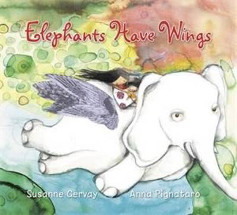Elephants have wings by Susanne Gervay

Ill. by Anna Pignataro. Ford St Publishing, 2014. ISBN 9781925000399
(hardcover). ISBN 9781925000405 (paperback).
(Age: 7+) Picture Book.
Elephant and the blind men
Once upon a time, there lived six blind men in a village. One day
the villagers told them, "Hey, there is an elephant in the village
today."
They had no idea what an elephant is. They decided, "Even though we
would not be able to see it, let us go and feel it anyway." All of
them went where the elephant was. Everyone of them touched the
elephant.
"Hey, the elephant is a pillar," said the first man who touched his
leg.
"Oh, no! it is like a rope," said the second man who touched the
tail.
"Oh, no! it is like a thick branch of a tree," said the third man
who touched the trunk of the elephant.
"It is like a big hand fan" said the fourth man who touched the ear
of the elephant.
"It is like a huge wall," said the fifth man who touched the belly
of the elephant.
"It is like a solid pipe," Said the sixth man who touched the tusk
of the elephant.
They began to argue about the elephant and everyone of them insisted
that he was right. It looked like they were getting agitated. A wise
man was passing by and he saw this. He stopped and asked them, "What
is the matter?" They said, "We cannot agree to what the elephant is
like." Each one of them told what he thought the elephant was like.
The wise man calmly explained to them, "All of you are right. The
reason every one of you is telling it differently because each one
of you touched the different part of the elephant. So, actually the
elephant has all those features what you all said."
"Oh!" everyone said. There was no more fight. They felt happy that
they were all right.
The moral of the story is that there may be some truth to what
someone says. Sometimes we can see that truth and sometimes not
because they may have different perspective which we may not agree
to. So, rather than arguing like the blind men, we should say,
"Maybe you have your reasons." This way we don't get in arguments.
In Jainism, it is explained that truth can be stated in seven
different ways. So, you can see how broad our religion is. It
teaches us to be tolerant towards others for their viewpoints. This
allows us to live in harmony with the people of different thinking.
This is known as the Syadvada, Anekantvad, or the theory of Manifold
Predictions.
http://www.jainworld.com/literature/story25.htm
Taking inspiration from this old moral tale used in many spiritual
traditions including Jainism, Buddhism, Hinduism and Sufism, Susanne
Gervay has created a beautiful story for children to explore 'the
humanity in all of us'.
After their father retells his version of the story, two children
are magically transported on a winged elephant to discover the
meaning of the parable. This beautiful tale is accompanied by
wonderful illustrations created from a variety of media in an
expressionistic style.
The book has been endorsed by the Blake Society with the Blake Prize
for art and poetry exploring themes of spirituality, religion and
human justice and links perfectly with the Australian Curriculum:
Asia & Australia's Engagement with Asia.
A beautiful addition to your collection for children Lower/Middle
school.
Sue Warren